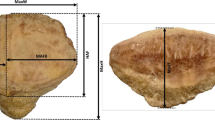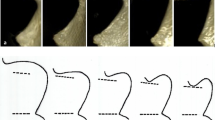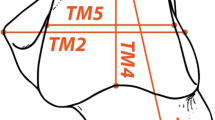Abstract
The greater sciatic notch (GSN) is a useful element for sex estimation because it is quite resistant to damage, and thus it can often be assessed even in poorly preserved skeletons. This study aimed to develop statistical models for sex estimation based on visual and metric analyses of the GSN, and additional variables linked to the GSN. A total of 60 left coxal bones (30 males and 30 females) were analysed. Fifteen variables were measured, and one was a morphologic variable. These 16 variables were used for the comparison of six statistical models: linear discriminant analysis (LDA), regularized discriminant analysis (RDA), penalized logistic regression (PLR) and flexible discriminant analysis (FDA), and two machine learning algorithms, support vector machine (SVM) and artificial neural network (ANN). The statistical models were built in two steps: firstly, only with the GSN variables (group 1), and secondly, with the whole variables (group 2), in order to see if the models including all the variables performed better. The overall accuracy of the models was very close, ranging from 0.92 to 0.97 using specific GSN variables. When additional variables starting from the deepest point of GSN are available, it is worth to use them, because the accuracy increases. PLR (after optimization of parameters) stands out from other statistical models. The position of the deepest point of GSN (Fig. 2) probably plays a crucial role for the sexual dimorphism, as stated by the good performance of the visual assessment of this point and the fact that the A2 angle (posterior angle with the deepest point of the GSN as the apex) is included in all models.
Highlights
-
Morphologic and metric evaluation of the greater sciatic notch from a contemporary French sample.
-
Comparison of six non-classical statistical models.
-
Plain morphologic assessment allows for nearly 92% of correct classification.
-
Accuracy ranges between 0.92 and 0.97 and 0.93 and 0.99 for targeted variables and all variables (targeted and non-targeted), respectively.
-
PLR with an optimization process gives the best accuracy with targeted variables.




Similar content being viewed by others
Data availability
Not applicable.
Code availability
Not applicable.
References
Ubelaker DH (1989) Human skeletal remains: excavation, analysis, interpretation (Manuals on archeology), 2nd edn. Taraxacum, Washington
Reichs KJ (1998), Postmortem dismemberment: recovery, analysis and interpretation. In: Reichs KJ, Forensic Osteology, 2nd edn. Charles C. Thomas Pub, Springfield 353-388
Moraitis K, Eliopoulos C, Spilioupoulou C (2013) Fracture characteristics of perimortem trauma in skeletal material. Internet j biol Anthropol 3(2):1–8
Sauer NJ (1998) The timing of injuries and manner of death: distinguishing among antemortem, perimortem and post-mortem trauma. In: Reichs KJ, Forensic Osteology, 2nd edn. Charles C. Thomas Pub, Springfield 321–332
Quatrehomme G (2015) Traité d’Anthropologie médico-légale. De Boeck Supérieur, Louvain-la-Neuve (Belgique)
Scheuer L (2002) Application of osteology to forensic medicine. Clin Anat 15(4):297–312
Đurić M, Rakočević Z, Đonić D (2005) The reliability of sex determination of skeletons from forensic context in the Balkans. Forensic Sci Int 147(2–3):159–164
Spradley MK, Jantz RL (2011) Sex estimation in forensic anthropology: skull versus postcranial elements. J Forensic Sci 56(2):289–296
Ferembach D, Schwidetzky I, Stloukal M (1979) Recommandations pour déterminer l’âge et le sexe sur le squelette. Bull Mem Soc Anthropol Paris 6(1):7–45
Colman KL, van der Merwe AE, Stull EK, Dobbe JGG, Streekstra GJ, van Rijn RR, Oostra RJ, Boer HH (2019) The accuracy of 3D virtual bone models of the pelvis for morphological sex estimation. Int J Legal Med 133(6):1853–1860
Walker PL (2005) Greater sciatic notch morphology: sex, age, and population differences. Am J Phys Anthropol 127(4):385–391
Clavero A, Salicrú M, Turbón D (2015) Sex prediction from the femur and hip bone using a sample of CT images from a Spanish population. Int J Legal Med 129(2):373–383
Krishan K, Chatterjee PM, Kanchan T, Kaur S, Baryah N, Singh RK (2016) A review of sex estimation techniques during examination of skeletal remains in forensic anthropology casework. Forensic Sci Int 261:165.e1-165.e8
Franklin D, Cardini A, Flavel A, Marks MK (2014) Morphometric analysis of pelvic sexual dimorphism in a contemporary Western Australian population. Int J Legal Med 28(5):861–872
Bytheway JA, Ross AH (2010) a geometric morphometric approach to sex determination of the human adult os coxa. J Forensic Sci 55(4):859–864
Blake KAS, Hartnett-McCann K (2018) Metric assessment of the pubic bone using known and novel data points for sex estimation. J Forensic Sci 63(5):1472–1478
Coelho J, Curate F (2019) CADOES: an interactive machine-learning approach for sex estimation with the pelvis. Forensic Sci Int 302:109873. https://doi.org/10.1016/j.forsciint.2019.109873
Steyn M, Işcan MY (2008) Metric sex determination from the pelvis in modern Greeks. Forensic Sci Int 179(1):86.e1–6
Robertson HI, Pokotylo DL, Weston DA (2019) Testing landmark redundancy for sex-based shape analysis of the adult human os coxa. Am J Phys Anthropol 169:689–703
Brůžek J, Santos F, Dutailly B, Murail P, Cunha E (2017) Validation and reliability of the sex estimation of the human os coxae using freely available DSP2 software for bioarchaeology and forensic anthropology. Am J of Phys Anthropol 64(2):440–449
Krogman WM, Iscan MY (1986) The human skeleton in forensic medicine, Charles C. Thomas, Springfield
Brůžek J (2002) A method for visual determination of sex, using the human hip bone. Am J Phys Anthropol 117(2):157–168
Phenice TW (1969) A newly developed visual method of sexing the os pubis. Am J of Phys Anthropol 30(2):297–301
Vacca E, Di Vella G (2012) Metric characterization of the human coxal bone on a recent Italian sample and multivariate discriminant analysis to determine sex. Forensic Sci Int 222(1–3):401.e1-401.e9
Torimitsu S, Makino Y, Saitoh H, Sakuma A, Ishii N, Yajima D, Inokuchi G et al (2015) Morphometric analysis of sex differences in contemporary Japanese pelves using multidetector computed tomography. Forensic Sci Int 257:530.e1-530.e7
Mahakkanukrauh P, Ruengdit S, Tun SM, Case DT, Sinthubua A (2017) Osteometric sex estimation from the os coxa in a Thai population. Forensic Sci Int 271:127.e1-127.e7
Djorojevic M, Roldán C, García-Parra P, Alemán I, Botella M (2014) Morphometric sex estimation from 3D computed tomography os coxae model and its validation in skeletal remains. Int J Legal Med 128(5):879–888
Murail P, Brůžek J, Houët F, Cunha E (2005) DSP: a tool for probabilistic sex diagnosis using worlwide variability in hip bone measurements. Bull mem Soc Anthropol Paris 17(3–4):167–176
Quatrehomme G, Radoman I, Nogueira L, du Jardin P, Alunni V (2017) Sex determination using the DSP (probabilistic sex diagnosis) method on the coxal bone: efficiency of method according to number of available variables. Forensic Sci Int 272:190–193
Kalsey G, Singla RK, Sachdeva K (2011) Role of the greater sciatic notch of the hip bone in the sexual dimorphism: a morphometric study of the North Indian population. Med Sci Law 51(2):81–86
Bonczarowska JH, Bonicelli A, Papadomanolakis A, Kranioti EF (2019) The posterior portion of the ilium as a sex indicator: a validation study. Forensic Sci Int 294:216.e1-216.e6
Gómez-Valdés JA, Quinto-Sánchez M, Garmendia AM, Veleminska J, Sánchez-Mejorada G, Bruzek J (2012) Comparison of methods to determine sex by evaluating the greater sciatic notch: visual, angular and geometric morphometrics. Forensic Sci Int 221(1–3):156.e1-156.e7
Jovanović S, Zivanović S (1965) The establishment of the sex by the greater sciatic notch. Acta Anat 61(1):101–107
Singh S, Potturi BR (1978) Greater sciatic notch in sex determination. J Anat 125(Pt3):619–624
Alizadeh Z, Hosseini A, Abkenari SA, Jabbari M (2013) Radiographic examination of the greater sciatic notch in determining the sex among Iranian people. Med Sci Law 53(2):85–89
Kim DH, Lee SH, Lee SS, Kim YS, Park SK, Han SH, Lee UY (2018) Comprehensive evaluation of the greater sciatic notch for sexual estimation through three-dimensional metric analysis using computed tomography based models. Legal Med 35:1–8
Takahashi H (2006) Curvature of the greater sciatic notch in sexing the human pelvis. Anthropol Sci 114(3):187–91
Velemínská J, Krajíček V, Dupej J, Goméz-Valdés JA, Velemínský P, Šefčáková A, Pelikán J, Sánchez-Mejorada G, Brůžek J (2013) Technical note: geometric morphometrics and sexual dimorphism of the greater sciatic notch in adults from two skeletal collections: the accuracy and reliability of sex classification: sexual dimorphism of the greater sciatic notch. Am J Phys Anthropol 152(4):558–65
Cohen J (1960) A coefficient of agreement for nominal class. Educ Psychol Meas 20:37–46
Haeb-Umbach R, Ney H (1992) Linear discriminant analysis for improved large vocabulary continuous speech recognition. In [Proceedings] ICASSP-92: 1992 IEEE International Conference on Acoustics, Speech, and Signal Processing, 1–16 vol.1. San Francisco, CA, USA: IEEE.
Santos F, Guyomarc’h P, Bruzek J, (2014) Statistical sex determination from craniometrics: comparison of linear discriminant analysis, logistic regression, and support vector machines. Forensic Sci Int 245:204.e1-204.e8
Nikita E, Nikitas P (2020) On the use of machine learning algorithms in forensic anthropology. Legal Med. https://doi.org/10.1016/j.legalmed.2020.101771
Stull KE, L’Abbé EN, Ousley SD (2017) Subadult sex estimation from diaphyseal dimensions. Am J Phys Anthrol 163(1):64–74
Hinić-Frlog S, Motani R (2010) Relationship between osteology and aquatic locomotion in birds: determining modes of locomotion in extinct ornithurae. J Evol Biol 23(2):372–385
Paliwal M, Kumar UA (2009) Neural networks and statistical technics: a review of application. Expert Syst Appl 36:2–17
Haykin S (2009) Neural networks and learning machines, 3rd edn. Prentice Hall, London
Ripley BD (1996) Pattern recognition and neural networks. Cambridge University Press, Cambridge
Du Jardin Ph, Ponsaillé J, Alunni-Perret V, Quatrehomme G (2009) A comparison between neural network and other metric methods to determine sex from the upper femur in a modern French population. Forensic Sci Int 192:127.e1-127.e6
James J, Witten D, Hastie T, Tibshirani R (2014) An introduction to statistical learning with applications in R. Springer, New York
Maroco J, Silva D, Guerreiro M, Santana I, de Mendonça A (2011) Data mining methods in the prediction of dementia: a real-data comparison of the accuracy, sensitivity and specificity of linear discriminant analysis, logistic regression, neural networks, support vector machines, classification trees and random forest. BMC res Notes 4:299
Landis JR, Koch GG (1977) The measurement of observer agreement for categorical data. Biometrics 33(1):159–174
Kurki H (2011) Pelvic dimorphism in relation to body size and body size dimorphism in humans. J Hum Evol 61(6):631–643
Yoldi A, Aleman I, Botella MC (2001) Funciones discriminantes del sexo a partir del ilion en una poblacion mediterranea de sexo conocido. Rev Esp Antrop Biol 22:23–38
Kranioti EF, Šťovíčková L, Karell MA, Brůžek J (2019) Sex estimation of os coxae using DSP2 software: a validation study of a Greek sample. Forensic Sci Int 297:371.e1-371.e6
Machado MPS, Costa ST, Freire AR, Navega D, Cunha E, Júnior ED, Prado FB, Rossi AC (2018) Application and validation of diagnose sexuelle probabiliste V2 tool in a miscegenated population. Forensic Sci Int 290:351.e1-351.e5
Feldesman MR (2002) Classification tree as an alternative to linear discriminant analysis. Am J Phys Anthropol 119(3):257–275
Reynès C, Sabatier R, Molinari N (2006) Choice of B-splines with free parameters in the flexible discriminant analysis context. Comput Stat Data Anal 51(3):1765–1778
Edwards C (2015) Growing pains for deep learning. Commun ACM 58:14–16. https://doi.org/10.1145/2771283
Olivier G (1960) Pratique anthropologique. Vigot Frère éditeurs, Paris
Acknowledgements
We wish to thank Marie-Catherine Francino for proofreading this article.
Author information
Authors and Affiliations
Contributions
Siam Knecht: conceptualization, methodology, investigation, writing, and editing.
Luisa Nogueira: conceptualization, methodology, investigation, writing, and editing.
Maël Servant: reviewing and editing.
Fréderic Santos: methodology, reviewing, and editing.
Véronique Alunni: reviewing and editing.
Caroline Bernardi: reviewing and editing.
Gérald Quatrehomme: conceptualization, methodology, writing, reviewing, and editing.
Corresponding author
Ethics declarations
Conflict of interest
The authors declare no competing interests.
Additional information
Publisher's note
Springer Nature remains neutral with regard to jurisdictional claims in published maps and institutional affiliations.
Rights and permissions
About this article
Cite this article
Knecht, S., Nogueira, L., Servant, M. et al. Sex estimation from the greater sciatic notch: a comparison of classical statistical models and machine learning algorithms. Int J Legal Med 135, 2603–2613 (2021). https://doi.org/10.1007/s00414-021-02700-1
Received:
Accepted:
Published:
Issue Date:
DOI: https://doi.org/10.1007/s00414-021-02700-1




